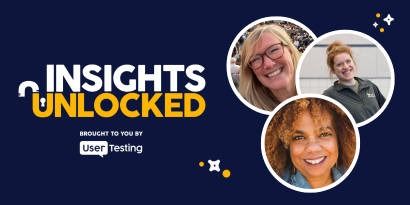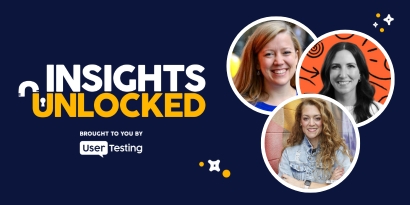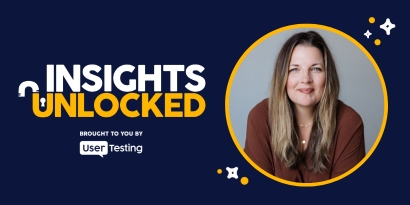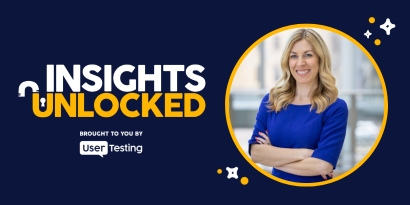
Episode 19 | June 14, 2021
Top customer experience insights from Season 2
Discover top customer experience insights from season two of Insights Unlocked. Learn how user insights drive better business decisions and CX strategies!
Unlocking customer experience success: lessons from Season 2 of Insights Unlocked
“If the best in the world still take time to talk to their customers and learn, shouldn’t we all?”
Customer experience (CX) is no longer a nice-to-have—it’s a competitive necessity. Companies that deeply understand their customers’ needs and behaviors are the ones leading their industries. But how do successful organizations foster a culture of empathy and user insights?
In the season two finale of Insights Unlocked, hosts Janelle Estes, Chief Insights Officer at UserTesting, and Andy MacMillan, CEO of UserTesting, reflect on some of the most powerful lessons shared by their expert guests. From creating customer-first cultures to leveraging human insights in decision-making, this season delivered invaluable takeaways for anyone looking to elevate their CX strategy.
Why curiosity is the foundation of great customer experiences
At the heart of every successful customer experience is curiosity—the willingness to ask questions, listen deeply, and challenge assumptions. Throughout the season, guests consistently demonstrated how curiosity drives meaningful improvements in CX.
"There’s this sort of endless curiosity that folks who come on our show have," said Estes. "And that’s what really makes them great leaders."

Unlike businesses that rely solely on data, companies that prioritize human insights take a more holistic approach, ensuring they understand not just what customers are doing, but why. For instance, Christine, one of the guests, shared how his career path took unexpected turns—from aspiring doctor to sales professional—before he found his passion in understanding user behavior. His journey, like many others featured on the podcast, underscored the value of staying open to learning and adapting.
"It’s not about checking a box—it’s about being genuinely interested and curious about your customers."
Winning buy-in for customer-centric initiatives
A recurring theme this season was the challenge of getting executive buy-in for CX improvements. Many organizations talk about being customer-centric, but only a few embed it into their culture and decision-making. So, how do you convince leadership to invest in customer experience initiatives?
John Couch from Hulu shared a compelling strategy: using vision videos to align teams around customer needs. By crafting an aspirational visual story, he was able to generate excitement and commitment across departments.
"You can suspend reality for a moment and say, ‘Let’s just imagine what’s possible.’ And once you’re clear about that vision, the conversation shifts from ‘We can’t do this’ to ‘How do we make this happen?’"
Catherine Richards from Tesco Bank took a different approach—she implemented Customer Wednesdays, a program that brings real customers into conversations with employees. By making customer stories a regular part of internal discussions, her team built a stronger emotional connection with the people they serve.
"If you don’t have executive-level support, you really have to question whether it’s the right place for you."
The acceleration of digital-first experiences
The pandemic fundamentally changed how businesses interact with customers, accelerating digital transformation across industries. One of the most striking examples came from Sean McKee at Schuh, who detailed how the traditional in-store shoe shopping experience has been reshaped by digital innovation.
"We saw this transformation happen over 10 to 15 years, but with COVID, it reached a whole new level overnight."
Even industries that historically relied on in-person interactions, such as automotive sales, have embraced digital-first strategies. McKee described how car dealerships are now using video test drives to help customers make purchasing decisions without stepping into a showroom.
Similarly, the team at MURAL explored how distributed collaboration is reshaping internal workflows. Remote teams face unique challenges in maintaining alignment and fostering innovation. By introducing rituals—such as "playbacks" at IBM or daily check-ins—companies are ensuring that the shift to digital doesn’t compromise collaboration.
"The companies winning today are the ones that realize they can’t just rely on data—they need to talk to people."
B2B vs. B2C: more alike than you think
One of the season’s standout conversations was with Susan Rice, who has worked in both B2B and B2C environments. While conventional wisdom suggests that B2B experiences lag behind their consumer-facing counterparts, Rice challenged this notion.
"It’s just not that simple," she explained. "Yes, B2B companies can learn from B2C, but the needs are different. A customer who uses your product all day long requires a different experience than someone who interacts with your brand for a few minutes."
The key takeaway? Regardless of whether you’re in B2B or B2C, the goal remains the same: make complexity simple. Understanding the jobs your customers need to accomplish and designing solutions that reduce friction is the ultimate competitive advantage.
The power of diverse perspectives
As Estes and MacMillan wrapped up season two, they looked ahead to future conversations around diversity in customer insights. The most innovative companies today are deliberately seeking perspectives beyond their immediate teams, ensuring they build products and experiences that serve a broad range of users.
"It’s easy to say, ‘You are not your customer,’" Estes noted. "But it’s another thing to be deliberate about getting those perspectives."
MacMillan agreed, emphasizing that truly customer-centric companies disrupt their own thinking by incorporating diverse viewpoints. As season three of Insights Unlocked approaches, the focus will be on uncovering how leading organizations are making this shift—and how others can follow suit.
The key lesson from this season? The companies that win are the ones that listen.
As Andy said, "If the best in the world still take time to talk to their customers and learn, shouldn’t we all?"










